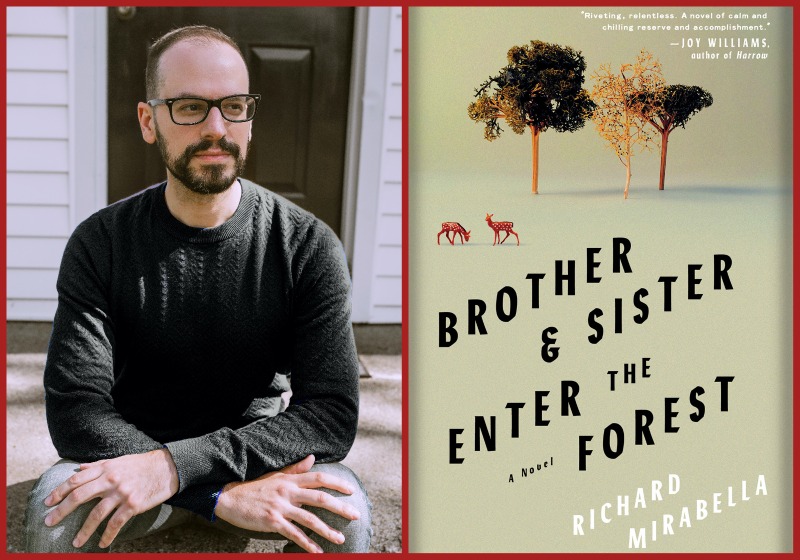
On April 27th at our Literary Debutante Ball, One Story will be celebrating nine of our authors who have recently published their debut books. In the weeks leading up to the Ball, we’ll be introducing our Debs through a series of interviews.
Today, we’re talking to Richard Mirabella, author of One Teen Story Issue #38, “Mold” and the novel Brother & Sister Enter the Forest (Catapult).
At the beginning of Richard Mirabella’s Brother & Sister Enter the Forest, Justin appears on his sister Willa’s doorstep, needing a place to stay. Justin’s building has ostensibly collapsed, but after a childhood of taking care of him, Willa has grown wary, and his presence threatens the careful, predictable life she has created for herself. In alternating chapters, we are given glimpses at the siblings’ turbulent home life and Justin’s doomed high school relationship with an older boy—a relationship that will drastically impact the trajectory of both siblings’ lives. With crisp prose and nuanced, complex characters, Brother & Sister Enter the Forest is a strikingly original fairytale unlike anything you have read. —Mara Sandroff
Mara Sandroff: Where were you when you found out that Brother & Sister Enter the Forest was being published? How did you celebrate?
Richard Mirabella: I was at home, working. It was January 2021, and I’d been working from home since March 2020, so I was wearing sweats and a t-shirt and I had a migraine and I was annoyed. My agent called to tell me the book had sold, and I cried. It had been a pretty long submission process. I took the rest of the workday off so I could sit around being happy and excited and call people.
MS: When you were first interviewed by One Story after your story “Mold” was published in 2016, you mentioned working on this novel. What has the process been like this since then?
RM: That was right at the beginning, and there was a rough road after that! It took me a long time to figure out what this novel was going to be. I rewrote it from beginning to end three times, and then revised it into the form it is today over several years. It really was a process of feeling things out. When “Mold” was published, I had a very messy first draft that only slightly resembles the novel I ended up with.
MS: Your book is loosely inspired by the fairytale “Little Brother and Little Sister.” What was it about the fairytale that first captured you, and how did the fairytale form influence your novel?
RM: I already knew I was writing a novel about siblings, but I wasn’t clear on how that would play out. I often go to fairy tales to help generate fiction, to the see if something sparks a surprising turn of events in something I’m writing. “Little Brother and Little Sister” is about transformation and care, and a curse. I didn’t want to retell it, but I used some of the concepts from it to help shape my novel over time. What first really captured me was the little brother recklessly drinking from the cursed stream, unable to help himself, and being turned into a fawn. And his sister vowing to care for him.
MS: Your story is told in two timelines. Rather than alternating between the two, Justin’s past appears at unexpected intervals, and we are not told the details sequentially. What was the process of writing these timelines and weaving the stories together? Were there other structures you tried before settling on this one?
RM: I tried to write the story in a pretty straightforward way at first. Starting with their childhood and then moving forward in a linear fashion. Then I changed it, focusing on their adulthood, and the past would invade on certain moments. Later, I realized I wanted the novel to be more like a shattered thing, and I began to move scenes around, place them next to each other, the past and present, different POVs, to try to build the world. I sort of followed my feeling a little bit, which sounds hokey, but it’s how I work. Does this feel right? Intellect and planning came later.
MS: I found Willa’s dioramas fascinating, and they’re such a rich and original literary device. What was the inspiration behind them?
RM: It’s funny, that was the first element of the novel to come about. Willa and her miniatures. They changed as I wrote the novel, but she always made dioramas, and I really don’t know where they came from. I just loved the image and concept. Making the world in miniature, making yourself this giant god, in control of the world. Creating and atmosphere in a little box. And I wanted the novel to be similar. A little contained world. Minimal and brutal.
MS: Lastly, what are you most looking forward to at the One Story ball?
RM: I am so excited to dress up and actually celebrate! I can’t wait to meet writers that I’ve only talked to and never met in real life.
Mara Sandroff is a fiction writer, essayist, and critic based in Brooklyn. She writes literary criticism for Newcity Lit and recently earned an MFA in fiction from NYU. Her work has been featured in the Emerging Writer Series of Roxane Gay’s The Audacity newsletter. She is an alumna or current participant in Catapult’s 2023 Novel in a Year class, Kenyon Review’s 2023 Winter Workshops (Nonfiction), Kenyon Review’s 2021 Writers Workshop (Fiction), and One Story’s 2019 Summer Writers Conference, as well as a 2021 finalist in Tucson Festival of Book’s Literary Awards and a voting member of the National Book Critics Circle. Other writing has also appeared in FF2 Media, Hey Alma, and One Story’s blog. She has received support for her in-progress novel from Catapult and Write On, Door County’s Writers Residency Program. Previously, Mara worked at One Story as an editorial intern.